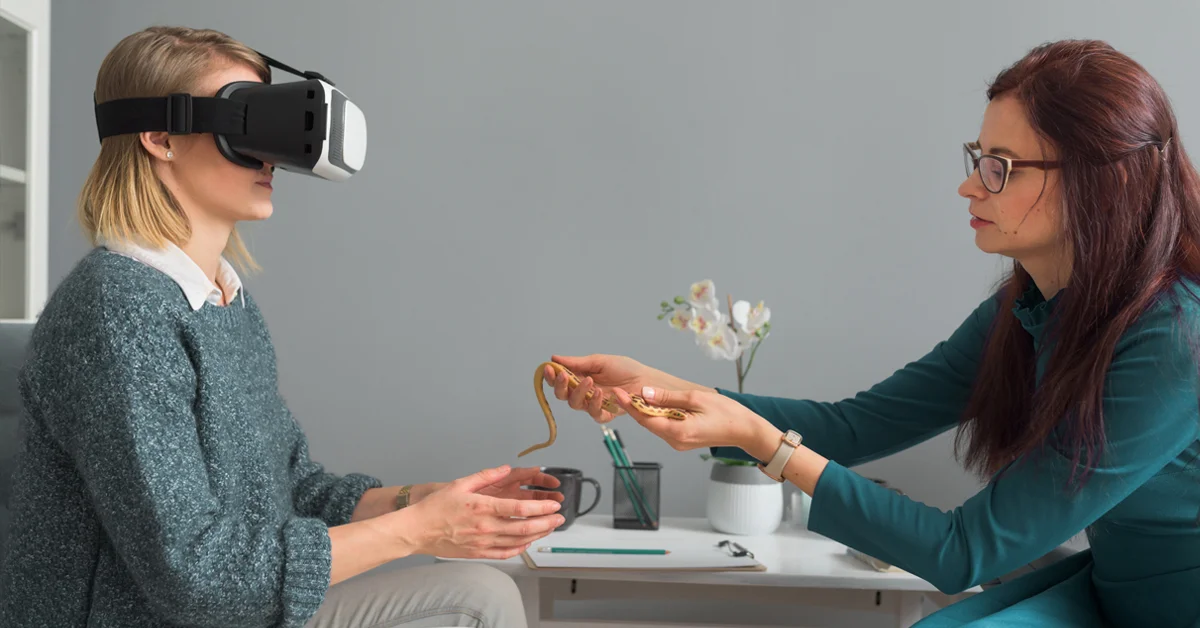Do you ever feel stuck in your comfort zone, unable to push past your fears and anxieties? Exposure Therapy is a proven method for breaking free from the limitations of anxiety and phobias by gradually exposing individuals to their fears. This therapy has been successful in treating a wide range of conditions, including anxiety disorders, phobias, PTSD, and OCD.
But what does it take to make progress in Exposure Therapy? It requires stepping out of your comfort zone and entering what is called the “Effort Zone”. This is where growth and progress happen. By facing your fears and challenging yourself to take on difficult tasks, you can expand your comfort zone and achieve greater success in life.
In this article, we’ll explore the transformative power of Exposure Therapy and the importance of stepping out of your comfort zone to enter your Effort Zone. We’ll discuss the principles behind Exposure Therapy, the different types of exposure, and what to expect during treatment. We’ll also share success stories of individuals who have overcome their fears by entering their Effort Zone and embracing the power of Exposure Therapy. By the end of this article, you’ll have a better understanding of how Exposure Therapy can help you break free from anxiety and phobias, and how stepping out of your comfort zone can lead to growth and success in all areas of life.
What is Exposure Therapy?
Exposure Therapy is a type of cognitive-behavioral therapy that is designed to help individuals overcome anxiety and phobias by gradually exposing them to their fears. It is based on the principle of habituation, which means that the more a person is exposed to a feared stimulus, the less anxiety they will experience over time.
During Exposure Therapy, the therapist will work with the individual to create a hierarchy of feared situations or objects. This hierarchy will be arranged from the least anxiety-provoking to the most anxiety-provoking. The therapist will then guide the individual through a series of exposures, starting with the least anxiety-provoking situation and gradually working up to the most anxiety-provoking situation.
For example, if someone has a fear of flying, their hierarchy might look something like this:
- Looking at pictures of airplanes
- Watching videos of airplanes taking off and landing
- Going to an airport and watching airplanes from a distance
- Going to an airport and watching airplanes take off and land from up close
- Taking a short flight
- Taking a longer flight

The idea is to start with the least anxiety-provoking situation and work up to the most anxiety-provoking situation, so that the individual can gradually build up their tolerance to the feared stimulus.
Exposure Therapy can take different forms, including in vivo exposure, imaginal exposure, and virtual reality exposure. In vivo exposure involves direct exposure to the feared stimulus, such as going to a public place for someone with social anxiety. Imaginal exposure involves imagining the feared stimulus, such as visualizing a spider for someone with arachnophobia. Virtual reality exposure involves using a virtual reality headset to simulate exposure to the feared stimulus, such as simulating a flight for someone with a fear of flying.
How Does Exposure Therapy Work?
Exposure Therapy works by helping individuals to gradually confront their fears in a safe and controlled environment. By repeatedly exposing themselves to the feared stimulus, individuals can learn to tolerate and eventually overcome their anxiety.
One of the key mechanisms behind Exposure Therapy is habituation, which is the natural process of becoming less sensitive to a stimulus the more it is encountered. In Exposure Therapy, this process is deliberately facilitated by systematically exposing the individual to increasingly challenging situations involving the feared stimulus.
The Effort Zones
During Exposure Therapy sessions, the therapist will typically guide the individual through a series of progressively challenging exposures. In other words, you exit your comfort zone and enter the Effort Zones.
If we take the example of someone who fears to speak in public, it could follow the following steps :
- Effort Zone 1 (the familiar zone) : The patient will be asked to deliver his speech in front of a mirror.
- Effort Zone 2 (the learning zone) : Once he will feel comfortable with his speech, he will deliver it in front of some friends and family
- Effort Zone 3 (the growth zone) : After several exposure on zone 2, he now has to deliver his speech to people he doesn’t know. Maybe in a university, meetup, conference, …
- Effort Zone 4 (the panic zone) : As we have seen in this article, the panic zone might be overwhelming. However, it’s here that we will get the most results out of it. The patient will deliver his speech in front of a larger audience
- Effort Zone 5 (the danger zone) : We tend to avoid this zone.
This may involve confronting the feared stimulus in different ways, such as through in vivo exposure, imaginal exposure, or virtual reality exposure, depending on the individual’s needs and preferences.
Types of Exposure Therapy
Exposure Therapy can take many different forms, depending on the individual’s needs and the nature of their fears or phobias.

Some common types of Exposure Therapy include:
- In Vivo Exposure: This involves direct exposure to the feared stimulus in real-life situations. For example, someone with a fear of heights may gradually expose themselves to higher and higher elevations, starting with a low balcony and progressing to a high rooftop. Or someone with a fear of dogs may gradually expose themselves to friendly dogs under controlled conditions, starting with looking at pictures of dogs and progressing to being in the same room as a dog.
- Imaginal Exposure: This involves exposure to the feared stimulus through vivid imagining or visualization. For example, someone with a fear of public speaking may be asked to imagine themselves delivering a speech to a large audience. We call it also “Visualization”
- Virtual reality exposure involves using technology to simulate exposure to the feared stimulus in a safe and controlled environment. This approach is particularly useful for fears that are difficult to replicate in real-life situations, such as fear of flying. By gradually exposing themselves to simulated flights, individuals can gradually overcome their fear and build confidence in their ability to cope with the anxiety.
- Interoceptive Exposure: This involves exposure to internal sensations that are associated with anxiety, such as increased heart rate or shortness of breath. For example, someone with panic disorder may be asked to exercise vigorously in order to experience these sensations and learn to tolerate them.
- Systematic Desensitization: This involves combining exposure to the feared stimulus with relaxation techniques, such as deep breathing or progressive muscle relaxation. For example, someone with a fear of spiders may be asked to imagine a spider while simultaneously practicing relaxation techniques to reduce their anxiety.
- Flooding: This involves intense and prolonged exposure to the feared stimulus, without the use of relaxation techniques or gradual exposure. This approach is typically reserved for individuals who have already undergone exposure therapy and have a high tolerance for anxiety.
What to Expect During Treatment
What I like about the Exposure Therapy and why I wanted to write an article about it, is that it works exactly like running a marathon or finishing an Ironman. It works in the same 4 steps :
- Defining the goal
- Evaluate your current situation (zones) and create the plan accordingly
- Execute the plan
- Achieve and rewards !
Before beginning Exposure Therapy, individuals will typically undergo an initial evaluation with a therapist or mental health professional to assess the nature and severity of their fears or phobias, as well as any other psychological or medical factors that may need to be addressed. The therapist will then work with the individual to develop a personalized treatment plan that is tailored to their specific needs and goals.
During the early stages of Exposure Therapy, the therapist will typically provide guidance and support as the individual gradually confronts their fears in a safe and controlled environment. This may involve using techniques such as relaxation, deep breathing, or guided imagery to help the individual cope with anxiety and stay focused on the exposure task.
As the individual progresses through Exposure Therapy, they will typically be asked to take on more challenging exposure tasks, gradually increasing their ability to tolerate and overcome their fears. This may involve facing situations that previously would have been too overwhelming or difficult to manage.
Throughout the treatment process, the therapist will provide ongoing support, guidance, and feedback to help the individual stay on track and achieve their treatment goals. They may also work with the individual to develop coping strategies and skills that can be used in everyday life to manage anxiety and prevent relapse.
The Benefits of Exposure Therapy
Exposure Therapy has been shown to be an effective treatment for a wide range of anxiety disorders, including phobias, panic disorder, social anxiety disorder, and post-traumatic stress disorder (PTSD). Here are some of the benefits that individuals may experience from undergoing Exposure Therapy:
- Reduced Anxiety: Exposure Therapy can help individuals to gradually overcome their fears and phobias, leading to a reduction in anxiety symptoms over time. This can improve their overall quality of life and help them to function more effectively in their daily lives.
- Increased Confidence: By successfully confronting and overcoming their fears, individuals can experience a boost in confidence and self-esteem. This can translate into greater success in other areas of their lives, such as work or relationships.
- Improved Coping Skills: Exposure Therapy can help individuals to develop new coping strategies and skills for managing anxiety and stress. These skills can be applied in a variety of situations, helping individuals to better handle everyday challenges and unexpected stressors.
- Long-Term Results: Exposure Therapy is often considered to be a “lasting” treatment, meaning that the benefits may continue even after treatment has ended. This is in contrast to other forms of therapy, such as medication, which may require ongoing use in order to maintain their effects.
Conclusion
Exposure Therapy can be a highly effective treatment for anxiety disorders, helping individuals to overcome their fears and phobias and achieve greater success and happiness in their lives. By gradually exposing themselves to their fears and entering their Effort Zone, individuals can expand their comfort zone and develop new coping skills and strategies for managing anxiety and stress.
It is important to work with a qualified mental health professional to determine the best treatment approach for your specific needs, and to have realistic expectations for the duration and results of Exposure Therapy. With patience, perseverance, and the support of a skilled therapist, individuals can overcome their fears and achieve greater success and happiness in their lives.
If you or a loved one is struggling with anxiety or a related condition, don’t hesitate to seek help. With the right treatment and support, you can overcome your fears and achieve your goals.

Leave a Reply